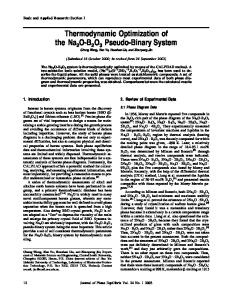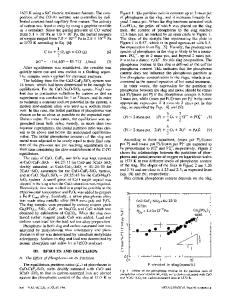Critical Evaluation and Thermodynamic Optimization of the Na 2 O-FeO-Fe 2 O 3 -SiO 2 System
- PDF / 3,337,935 Bytes
- 18 Pages / 593.972 x 792 pts Page_size
- 15 Downloads / 472 Views
I.
INTRODUCTION
THE Na2O-based flux Na2O-FeO-Fe2O3-SiO2 was studied for the desulfurization (de-S)[1–4] and dephosphorization (de-P)[1–3] of hot metal and liquid steel. The Na2O-FeO-Fe2O3-SiO2 system is also one of the fundamental oxide systems for the coal-combustion slag,[3,5,6] bio-glasses,[7–9] and geological Fe-bearing silicate rocks. Many investigations were performed to determine phase equilibrium relations and thermodynamic properties of the Na2O-FeO-Fe2O3-SiO2 system.[1–4,10–26] However, available experimental results are inconsistent and incomplete in terms of temperature and composition. Accurately controlling the oxygen partial pressure to define the valence of Fe oxide in solid and liquid states, the high vapor pressure of sodium, and the hygroscopic nature of Na2O-rich components make experimental studies of this system very challenging. The purpose of the present study was to critically evaluate and optimize thermodynamic properties and phase diagrams of the Na2O-FeO-Fe2O3-SiO2 system. The optimization of this system was not attempted, previously. In the thermodynamic ‘‘optimization’’ of a system, all available thermodynamic property and phase equilibrium data are evaluated, simultaneously, to obtain a set of model equations for the Gibbs energies
ELMIRA MOOSAVI-KHOONSARI, Ph.D. Student, and IN-HO JUNG, Associate Professor, are with the Department of Mining and Materials Engineering, McGill University, 3610 University Street, Montreal, QC H3A 0C5, Canada. Contact e-mail: in-ho.jung@ mcgill.ca Manuscript submitted February 6, 2015. METALLURGICAL AND MATERIALS TRANSACTIONS B
of all phases as functions of temperature and composition. Thermodynamic property data such as activity aid in the evaluation of phase diagrams, and phase diagram measurements are used to deduce thermodynamic properties. From optimized Gibbs energy equations, all thermodynamic properties and phase diagrams can be back-calculated. In this way, all data are rendered self-consistent and consistent with thermodynamic principles. Discrepancies among available data are often resolved, and interpolations and extrapolations are made in a thermodynamically correct manner. The optimized thermodynamic database which is self-consistently built from low-order to high-order systems can be applied to industrial processes. Critical thermodynamic optimizations of the Na2OSiO2,[27] FeO-Fe2O3,[28] FeO-SiO2, and Fe2O3-SiO2[29] systems were already performed and stored in the FactSage FACT oxide (FToxid) database. We also conducted thermodynamic optimizations of the Na2O-FeO, Na2OFe2O3 and Na2O-FeO-Fe2O3 systems previously.[30] In this study, the evaluation/optimization of the Na2O-FeOFe2O3-SiO2 system was carried out based on the previously optimized model parameters. This work is part of a wide database development project for the multi-component system Na2O-FeO-Fe2O3-SiO2-Al2O3-CaO-MgO, which plays a key role in many applications in ironmaking, steelmaking, glassmaking, cement production, combustion, and geology.
II. EQUILIBRIUM PHASES AND THERMODY
Data Loading...











